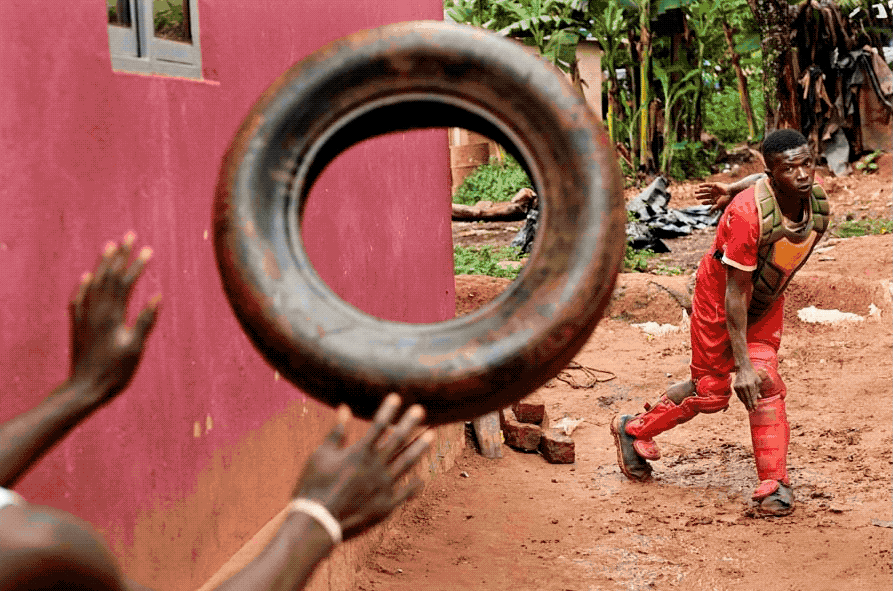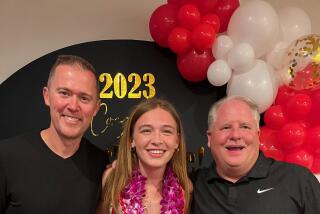Reluctant Hero Nears End of That Long Season Back : College football: Seay forgives CS Long Beach but won’t forget what it has cost him to play with one kidney.
- Share via
Mark Seay did not attend a children’s party this Halloween. “My sister and I talked about having one and then we thought, ‘Oh, no, remember what happened the last time,’ ” said the Cal State Long Beach football player who was shot by a suspected gang member at a Halloween party two years ago as he shielded his 2-year-old niece.
Seay, who lost a kidney as a result of the shooting, still feels betrayed by university officials who would not let him play last year because of the risk of damaging his other kidney. He is playing now only after taking legal action against the university.
The junior wide receiver will finish his comeback season Saturday when the 49ers play Nevada Las Vegas at Veterans Stadium. Seay is among the leading receivers in the Big West Conference with 45 catches for 709 yards. He has caught four touchdown passes. Last Saturday, he caught a tipped two-point conversion pass as Long Beach defeated Cal State Northridge, 25-24.
“I’m not satisfied, but it’s gone pretty good,” Seay said. “If I don’t perform the way I should, if I’m not happy, I always think about the time when I thought I’d never be playing again.”
Long Beach Coach George Allen said: “He’s an example for all of us, what I call a solid citizen. He’s a leader. One of the highlights of my coaching career is having a guy like Mark Seay on my team.”
The only difference Seay has noticed in playing football with one kidney rather than two is the extra protective equipment he must wear. “I put on a pad that protects my back area and my hip, and then I put on a flak jacket,” he said. “At first, I just wanted to yank it off because I was the type of player who wore as few pads as I could get away with.”
But he is glad he has worn it.
“I’ve never been hit as hard as I’ve been hit this year,” said Seay, who is 6 feet and 175 pounds. “I’ve taken my share of hits.”
Only once, in a game at Jack Murphy Stadium against San Diego State, was he worried. “A guy was on top of my back and slammed me into the infield area where it’s all dirt. I coughed up some blood. That was scary. But I didn’t think it had anything to do with my kidney.”
Seay has detected a tendency in people to think that when he makes a mistake in a game, it must be related to his disability.
Against New Mexico State, an embarrassed Seay caught a kickoff and, thinking he was in the end zone instead of on the two-yard line, dropped to one knee and downed the ball. “Some of the (assistant) coaches didn’t think I was myself, I think simply because of what happened to my kidney,” Seay said. “It made me angry. They kept asking me how I felt. I felt great. I just didn’t know where I was. It could have happened to anybody.”
Seay said he has a urine test after each game and has had one 24-hour creatinine clearance test--a measure of kidney function. “They said I was fine,” he said.
Trainer Dan Bailey said last week that he could not discuss Seay’s kidney tests because, he said, Seay never signed a consent form, as most players do, for release of medical information to the media.
Seay has chosen to play despite the prospect of having to be hooked to a dialysis machine should his remaining kidney be damaged.
“I think about that all the time,” he said. “It could happen, nothing’s promised to you in this world. But I’m 23 years old, and I’m not going to let anyone dictate my life. I was cheated out of one (kidney). If I’m going to lose this one, I’m not going to be cheated. I’m going to end up losing it doing something I want to do.”
The quiet, introspective Seay, who grew up in San Bernardino, has been besieged with interview requests. He realizes he will probably always be known for having one kidney rather than for his football playing ability. “I didn’t ask for any of this,” he said. “A lot of times I don’t know what to do with it. I’m not the type of guy who likes being in the spotlight.”
But one has shined brightly on him nonetheless.
He seems perplexed by the national acclaim he received for saving his niece. “I never have thought of myself as a hero,” he said. “I’d like to know who made up the word hero , because really I don’t know what it is. I look at myself as I did before this even happened. I am what I am; I’m nothing more or nothing less. If they want to keep calling me a hero, and that’s what makes them happy, fine.”
When Seay awoke in the hospital after his kidney was removed, he wondered if he would play football again. He said university officials, including President Curtis McCray and Athletic Director Corey Johnson, visited him. “They said, ‘We hope you make it back, we’re behind you 100%,’ ” Seay recalled. “I felt good because these people were among the reasons I came to this university.”
In January 1989, Seay returned to classes and began working out. He suited up for spring practice and fully expected to play in the 1989 season. He recalled visiting McCray in his office. “He told me he’d do anything in his power to see that I was back out there,” Seay said.
But in June Seay was told by Johnson and team physician Robert Austin that he was being declared medically ineligible.
“It was a shock,” Seay said. “They told me I wouldn’t be able to go to another school because I wouldn’t be accepted, and as far as going pro (was concerned), I wouldn’t be able to pass the physical. They said the best thing was to retire and be a coach.
“I wish they would have let me know what was going on up front so I could have known what to do with myself. There were no warnings, nothing. I was in a lot of stress. They left me with no support. They’re dealing with young men, not professionals. If I was a weak-minded person, I could have committed suicide. You do not play with young men’s lives like that.”
Seay sued the university in an effort to keep playing, but in September 1989, a U.S. district judge, saying that there was insufficient evidence to determine if Seay’s remaining kidney was working properly, denied a request for an injunction that would have forced the university to let him play.
“At the hearing, instead of Corey coming up to me and saying, ‘I’m sorry,’ he came up and said, ‘So what’s next, are you going to be a coach?’ ”
Last winter, with the case expected to proceed to trial, Long Beach hired Allen as its football coach. “I didn’t start feeling better until he came,” Seay said. “I knew he was behind me when he told me, ‘If they don’t let you play here, I can get you a shot in the NFL . . . but I know they’re going to let you play.’ ”
Last spring, the lawsuit was settled out of court, and Seay, after passing medical tests, was allowed to rejoin the 49ers this season. He signed a waiver absolving the university of liability if he should suffer an injury to his kidney.
“It was difficult to deny him his dream,” Johnson said at a news conference at the time.
“They tried, anyway,” Seay said the other day. “If they didn’t think they were gong to lose (in a trial), I’m sure they would have stuck to their position. But I have no animosity toward them. I forgive them but I don’t forget, I’ll never forget.”
Seay’s smile was brilliant Saturday afternoon after the 49ers had beaten Northridge on his two-point conversion catch.
“Mark, Mark,” a silver-haired man called. It was McCray, the university president, rushing up with congratulations. It was a special moment, and Seay basked in it.
He walked off the field looking like any other football hero, and it was hard to imagine that he has only one kidney and that the bullet that pierced his other one is lodged three inches from his heart.
More to Read
Go beyond the scoreboard
Get the latest on L.A.'s teams in the daily Sports Report newsletter.
You may occasionally receive promotional content from the Los Angeles Times.










